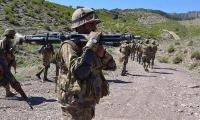Balochistan is in turmoil. At one end, there are peaceful mass demonstrations. On the other, an active violent insurgency that is spilling over outside the province. Common to both is anger, fed by a sense of powerlessness, redundancy and lack of stake in political as well as economic spheres. And not without cause.
Politically, Balochistan’s representation in Islamabad is, at best, weak and nominal. Balochistan has 17 seats in the 342-member National Assembly and 23 in the 100-member Senate. That translates to 5.0 per cent and 23 per cent, respectively. Representation in the National Assembly is so low that even if all Balochistan members remain absent, quorum is not affected, and deliberations and legislation can continue. Balochistan is irrelevant.
Representation in the Senate at nearly a quarter is respectable. However, the Senate does not command any budgetary powers. And it is the budget that arms parliament with veto powers over executive decision-making. Without budgetary powers, the Senate – and by implication, Balochistan – lacks effective leverage in national policymaking.
Occasionally, legislation is carried out in joint sessions of the National Assembly and the Senate. Herewith, Balochistan has 40 seats in the 442-member House – less than 10 per cent. Here again, the total absence of all Balochistan members does not impact on quorum requirements. Essentially, Balochistan faces a situation of political redundancy, contributing to a lack of stake in national affairs.
The sense of powerlessness pervades the provincial civil services as well. The constitution, including the 18th Amendment – both drafted by elected representatives of the people – envisages a state and society based on justice and fairness for all classes and areas of the country and, accordingly, adequate and equitable representation in civil services. Unfortunately, the goals enshrined in the constitution remain to be achieved. The civil service recruitment and promotion system that has been put in place has created a situation where some provinces are over-represented and some under-represented. Balochistan represents the latter case.
The general absence of officers from Balochistan in federal services has been noted time and again. The matter was taken up in 1993 and then again in 2004, whence a Cabinet Committee was set up and which submitted its report in 2006. The committee reviewed the situation over the decade 1993-2002 and reported a 15 per cent shortfall in Balochistan’s representation in federal services, with the gap filled in by officers from Punjab and Khyber-Pakhtunkhwa. A number of recommendations were made to redress the situation. None were implemented.
In 2013, the present author carried out a review, with a focus on Balochistan, of 53 Administrative Divisions and offices of the federal government that comprised 42 administrative divisions and 11 other key offices. The key offices included the president and prime minister’s secretariats, National Assembly and Senate secretariats, Supreme Court secretariat, Election Commission, Wafaqi Mohtasib, Federal Tax Ombudsman and National Accountability Bureau.
Total employment, therewith, in Basic Pay Scales 1 to 22 stood at 446,816 persons. Of these, 18,395 or 4.1 per cent, were from Balochistan – one percentage point less than its population share. The province’s share in BPS 17-22 was even lower at 3.9 per cent and that in BPS 20-22 a mere 2.1 per cent. In absolute terms, there were only 32 Balochistan-domiciled officers out of a total of 1,525 officers in BPS 20-22.
Viewed in terms of gaps provides more clarity. There were no BPS-20-22 Balochistan-domiciled officers in 31 out of 53 divisions and offices and no BPS-22 Balochistan-domiciled officers in 47 out of 53 divisions and offices. Key divisions and offices without BPS-22 officers from Balochistan included cabinet, communications, defence, economic affairs, interior, petroleum and natural resources, planning and development, ports and shipping and water and power divisions and offices of the president, prime minister, National Assembly, Senate, Supreme Court and Election Commission. Ironically, even with respect to lower grades, BPS 1-4, there were 13 out of 53 divisions and offices with no Balochistan-domiciled personnel.
One factor in Balochistan’s under-representation is a peculiar twist in the federal recruitment procedure. Individual advertisements for vacancies apply provincial quotas for each position. Accordingly, one Balochistan-domiciled person can be appointed to the post if, and only if, there are at least 17 vacancies – given that Balochistan’s quota is 6.0 per cent and one out of 17 equals 6.0 per cent. Where the number of vacancies in each position is less than 17, Balochistan’s 6.0 per cent quota works out to less than one: zero. As such, Balochistan-domiciled persons remain ineligible to apply.
The situation portrayed above continues to this day. And the consequence is that the shortfalls are filled in by officers from other provinces. In strategic terms, the absence of Balochistan-domiciled officers in the top echelons of the civil service means that the province has little say in national-level policymaking at administrative levels, compounding the situation of weak and ineffective representation at the political level.
The situation in Balochistan is screaming abject disaffection. There is a strong sense of powerlessness in political and administrative spheres. This perception pervades the provincial civil services as well – and not without cause. The continuing gap in Balochistan’s representation in the federal civil services is compounded by the representational distortions in the provincial service structure as well.
The constitution, reinforced by the 18th Amendment, declares Pakistan to be a federal state. Yet, the civil service structure in the provinces amounts to a violation of the parameters of provincial autonomy. The provision for adequate representation has been interpreted to imply the institution of quotas for the provinces, which has created a de facto situation where some provinces are over-represented and some under-represented. The system provides for the posting of federal as well as provincial officers on provincial posts.
Specifically, there is a sharing mechanism, whereby certain levels of provincial posts are filled by federal officers and the remaining by provincial officers. The mechanism is the product of an arbitrary administrative decision made by the caretaker federal government on September 19, 1993.
The meeting was chaired by the unrepresentative caretaker prime minister, with rather high-powered attendance that included all provincial caretaker governors and chief ministers, secretary and special secretary to the prime minister, deputy chairman of the Planning Commission, federal secretaries of establishment, finance, interior, food and agriculture, environment and urban affairs, industries, education divisions, chairman of the Prime Minister’s Monitoring & Evaluation Cell, all provincial chief secretaries and, ironically, heads of the Pakistan Postal Services Corporation and Utility Stores Corporation as well. Provincial chief secretaries are federal officers; as such, there was no provincial representation at all.
The federal-provincial sharing formula is such that the federal share rises and the corresponding provincial share falls as the BPS level rises. Accordingly, at the BPS-17 level, the federal share is one-fourth, and the provincial share is three-fourths. At the BPS-18 level, the federal share rises to 40 per cent and the provincial share declines to 60 per cent. At the BPS-19 level, the federal-provincial shares are equal at 50 per cent. At the BPS-20 level, the shares reverse, with the federal share at 60 per cent and the provincial share at 40 per cent. At the BPS-21 level, the federal share rises to two-thirds and the provincial share declines to one-third; and at the highest level of BPS-22, the federal share is 100 per cent and the provincial share zero.
The above formula translates for Balochistan as follows. Of the total number of BPS-17 posts in the province, the share of federal officers is 20 and that of provincial officers 60; of the total number of BPS-18 posts, the share of federal officers is 47 and that of provincial officers 71; of the total number of BPS-19 posts, the shares of federal and provincial officers are equal at 42; of the total number of BPS-20 posts, the share of federal officers rises to 25 and that of provincial officers falls to 17. There are eight BPS-21 positions, of which five are held by federal officers and three by provincial officers. There is one BPS-22 post, that of chief secretary, which is held by a federal officer.
The formula for the appointment of police officers is the same as above, with recruitment and promotions governed by the Police Order 2002, enacted during the Musharraf regime and a law that impacts Balochistan particularly adversely. There are two parallel BPS-17 cadres – additional superintendent of police (ASP) and deputy superintendent of police (DSP). ASPs are federal officers, recruited through the Federal Public Service Commission on an all-Pakistan basis, where Balochistan’s share is a mere 6.0 per cent. DSPs are provincial officers, promoted from the provincial Inspector level, who have themselves been recruited at the constable and ASI level and risen up the ranks.
The problem is that officers recruited at the constable or ASI level reach close to retirement age by the time they are in a position to be promoted to the DSP level. Resultantly, the vacant provincial DSP positions are filled by federal ASPs.
A purview of the above shows that the de-facto composition of the Balochistan civil services, including the police service, starkly portrays the imbalance between federal and provincial administrative writs, with provincial officers virtually edged out from the upper echelons of the hierarchy. The sheer dominance of federal officers is evident across the board.
The writer represented Sindh on the 7th NFC and now represents Balochistan. He tweets/posts @kaiserbengali
Economic nationalism remains potent political narrative, influencing both Republican and Democratic platforms
Yes, blockchain, decentralised and distributed ledger technology, is foundational backbone of cryptocurrencies
Blue carbon covers merely 2.0 per cent of ocean surface but absorbs 50 per cent of carbon dioxide
During WWII, Japan’s economy and national morale were plummeted by its doomed alliance with Germany
More than 40 persons, including women and children, were killed in Parachinar
After November 30, it will be impossible for ordinary internet users to access all banned websites, including X







